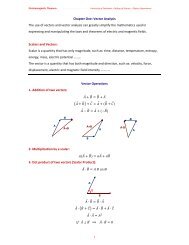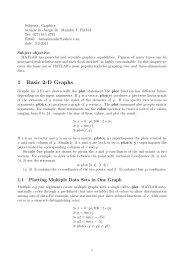Sentence Relations in the Writing of EFL Students at University Level
Sentence Relations in the Writing of EFL Students at University Level
Sentence Relations in the Writing of EFL Students at University Level
You also want an ePaper? Increase the reach of your titles
YUMPU automatically turns print PDFs into web optimized ePapers that Google loves.
Therefore, reference signals '<strong>the</strong> same member' unless marked as different<br />
by <strong>the</strong> use <strong>of</strong> comparison; while substitution signals 'ano<strong>the</strong>r member <strong>of</strong> <strong>the</strong><br />
same class' unless marked as identical by same. (Halliday 1985: 302).<br />
McCarthy (1991:46) makes ano<strong>the</strong>r difference between substitution and<br />
reference, st<strong>at</strong><strong>in</strong>g th<strong>at</strong> substitutes can be modified ( ‘ a red one’, ‘ <strong>the</strong> one<br />
<strong>in</strong> <strong>the</strong> corner’), while pronouns cannot be modified <strong>in</strong> this way (*a red it,<br />
*<strong>the</strong> it <strong>in</strong> <strong>the</strong> corner).<br />
5.2.2.3 Ellipsis<br />
Closely rel<strong>at</strong>ed to substitution is <strong>the</strong> cohesive device <strong>of</strong> ellipsis,<br />
where <strong>the</strong>re is omission <strong>of</strong> a second mention <strong>of</strong> items which can be<br />
understood as implicit. This gramm<strong>at</strong>ical process avoids unnecessary<br />
repetition and is more economical. Ellipsis has a cohesive effect because it<br />
is only used when a word or phrase is completely predictable th<strong>at</strong> <strong>the</strong><br />
speakers/writers assume wh<strong>at</strong> is miss<strong>in</strong>g from <strong>the</strong> context and <strong>the</strong> miss<strong>in</strong>g<br />
<strong>in</strong>form<strong>at</strong>ion is autom<strong>at</strong>ically filled <strong>in</strong>:<br />
2. Haworth is best <strong>in</strong> w<strong>in</strong>ter. Hawes <strong>in</strong> summer. (Jeffries 2006:186)<br />
The second sentence here is l<strong>in</strong>ked to <strong>the</strong> first by <strong>the</strong> fact th<strong>at</strong> we know<br />
th<strong>at</strong> <strong>the</strong> verb and complement “is best” is miss<strong>in</strong>g, such ellipsis as a<br />
cohesive mechanism across sentence boundaries is most frequent <strong>in</strong><br />
<strong>in</strong>formal and spoken language styles.<br />
5.2.2.4Conjunction<br />
The fourth and f<strong>in</strong>al type <strong>of</strong> gramm<strong>at</strong>ical cohesion is conjunction.<br />
Conjunctive elements are not" devices for reach<strong>in</strong>g out <strong>in</strong>to <strong>the</strong><br />
preced<strong>in</strong>g or follow<strong>in</strong>g text "like reference, ellipsis or substitution.<br />
Ra<strong>the</strong>r <strong>the</strong>y are cohesive" by virtue <strong>of</strong> <strong>the</strong>ir specific mean<strong>in</strong>g”<br />
(Halliday and Hasan 1976: 226).<br />
Thus, conjunction cre<strong>at</strong>es cohesion by rel<strong>at</strong><strong>in</strong>g sentences and<br />
paragraphs to each o<strong>the</strong>r by us<strong>in</strong>g words from <strong>the</strong> class <strong>of</strong> conjunction.<br />
This can be additive, advers<strong>at</strong>ive, causal, temporal or cont<strong>in</strong>u<strong>at</strong>ive.<br />
5.2.2.5 Lexical Cohesion<br />
In lexical cohesion <strong>the</strong> rel<strong>at</strong>ionship <strong>of</strong> cohesion is realized by<br />
vocabulary, i.e. by word. The discussion <strong>of</strong> lexical cohesion deals with two<br />
varieties: reiter<strong>at</strong>ion and colloc<strong>at</strong>ion. The difference between <strong>the</strong> two is<br />
th<strong>at</strong> while <strong>the</strong> former preserves reference between two rel<strong>at</strong>ed items, <strong>the</strong><br />
l<strong>at</strong>ter does not, <strong>the</strong> former is classified <strong>in</strong>to four types: same word<br />
(repetition), synonym (or near synonym), super ord<strong>in</strong><strong>at</strong>e and general<br />
word. (Halliday and Hasan 1976:274)<br />
Consider <strong>the</strong> illustr<strong>at</strong>ion <strong>of</strong> each <strong>of</strong> <strong>the</strong>se <strong>in</strong> turn<br />
6. D<strong>at</strong>a Collection<br />
6.1 The Sample<br />
The sample <strong>of</strong> <strong>the</strong> study is one hundred fourth year students:<br />
fifty from <strong>the</strong> College <strong>of</strong> Languages and fifty from <strong>the</strong> College <strong>of</strong> Educ<strong>at</strong>ion<br />
for Human Sciences <strong>in</strong> <strong>the</strong> <strong>University</strong> <strong>of</strong> Salahadd<strong>in</strong> for <strong>the</strong> academic year<br />
(2006-2007).<br />
The students are chosen randomly from one hundred and thirty eight<br />
students <strong>of</strong> both colleges .The reason for choos<strong>in</strong>g <strong>the</strong> fourth year students<br />
for this test is th<strong>at</strong> <strong>the</strong> fourth year students are supposed to have sufficiently<br />
mastered <strong>the</strong> writ<strong>in</strong>g process after tak<strong>in</strong>g courses <strong>in</strong> Guided Composition,<br />
Free Composition, and Essay Writ<strong>in</strong>g <strong>in</strong> <strong>the</strong> college.<br />
6.2 The Tool<br />
6.2 .1 The Test<br />
A test <strong>of</strong> (5) topics was designed and <strong>the</strong> students were asked<br />
@@@@@@@@@@@Journal <strong>of</strong> Zankoy Sulaimani. Part B. No. 29 June 2010@ 214@

















